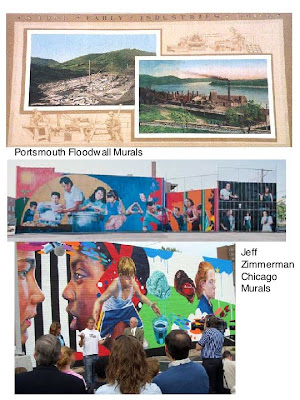Starting in Mexico, the movement expressed the cultural side of the Mexican Revolution, emphasizing the mestizo character of the new Mexican state as well as representing the populist and Marxist leanings of its three great painters, Rivera, Orozco, and Siqieros.

Around the same time in Anglo-America, the WPA arts projects gave the interior of public buildings as a canvas for similarly motivated painters of the American Scene genre.
Muralism saw a rebirth in the 1960s & 1970s with the advent of populist identity politics, often fusing the stylistic and aesthetic agendas of the American Scene and the Mexican Muralist movements, and eventually transcending them.
Famous murals from this era are Judy Baca’s Great Wall of Los Angeles and Chicago’s Wall of Respect.
The movement has moved beyond a certain explicit didactic purpose to celebrate community and history.
Good examples of this are the work of Jeff Zimmerman, who involves community members as subjects in his murals, which usually are fairly open-ended in interpretation, and the Portsmouth Floodwall Murals, which are both historical and celebrate aspects of modern Portsmouth…
 …and some of the murals coming out of the California Chicano community, like the one from the Estrada Courts housing complex.
…and some of the murals coming out of the California Chicano community, like the one from the Estrada Courts housing complex. 
There is always a bit of a populist back-story to murals, as in how the Portsmouth murals celebrate that city’s industrial past, but feature the workers in these plants, not just the industrialists).
Oregon Murals?
As a way of dealing with the blank facades of the porn shops, and instead of tearing them down for what would probably be more parking, how about keeping the buildings but using them as a public mural project on the theme of Oregon history?
Four murals
1. Theme of First Settlement: Development of a German working class community & the industral city, featuring lost buildings and local industry as well as images of the former residents.
2. Theme of Appalachian Migration: From the mountains and coalfields, down the hillbilly highways to Oho. Work in modern factories, and also indtroducing a cultural theme of honky tonks and the start of bluegrass music in Dayton, including portraits of performers or groups that played here.
 3. Theme of the Urban Pioneers: Urban renewal threat and restoring the neighborhood after near abandonment, including working in some portraits of locals still living in the area.
3. Theme of the Urban Pioneers: Urban renewal threat and restoring the neighborhood after near abandonment, including working in some portraits of locals still living in the area.4. Theme of Oregon as Center of Cultural Production: the live music scene (bands and singers and so forth) and the new arts scene, and maybe master chefs and sous chefs in a restaurant: a different type of creativity.

Using a bit of a Jeff Zimmerman mural to show what it might look like?
another theme that I have enjoyed during trips to DC is to create images that create optical illusions that blend in with their surroundings. Such as a large window that seemingly allows you to see through the building and the view on the other side.
ReplyDeleteLook up and down Jefferson St for some ideal locations: Price Stores (North side), Air City Garage (N), 24 N Jefferson (S), Bernie's Music (S). There are also some half-storefronts on Merchant's row that would be great (Anybody's pawn, MJ's Cafe).
ReplyDeleteThanks, Jeffrey. My father & Mike Elsass & I are working on the Oregon Arts district...I've been sharing info on muralists with this in mind. If you or others have ideas, continue to post them here. We're also bringing in perhaps the nation's authority on public spaces, the Project for Public Spaces (www.pps.org) in April to study 5th Street and these kinds of placemaking improvements.
ReplyDelete"There are also some half-storefronts on Merchant's row that would be great (Anybody's pawn, MJ's Cafe)."
ReplyDeleteActually MJs might be open to this idea as they show original art inside the bar.
..@ thanks for reminding me of Merchants Row. I need to blog on that place.
kate, yes I have read about Project for Public Spaces, and look forward to what they come up with.
ReplyDeleteJeffrey,
ReplyDeleteI tried to comment on this yesterday on DaytonOS, but alas, something went wrong... Anyway, I got to hear Bob Schiffler speak at the Dayton Chamber Breakkfast Briefing on Friday the 14th of March, and this was a big part of his presentation. He showed some wonderful murals from Philly, Chicago, Cleveland, and other cities across America. This is a great idea. If only I could paint...and would not get arrested. Great post.
"...create images that create optical illusions that blend in with their surroundings"
ReplyDeleteTromp'D Oeil. Best seen in baroque painting, particularly frescos and murals. There are some examples in the US, too. A muralist Richard Haas, I think, does that.
to David Bowman:
ReplyDeleteI had put this together as a follow up to a post on "finishing Fifth Street", about the vacant or underused buildings there, but hesitated to post it as I thought it was sort of pointless to make speculations like this
After Esrati posted on Schifflers speech I decided to post it since it seems I'm not the only one thinking about murals and public art as a possibility.
How about some bigger than life Dayton inventions such as a three story standard cash register or a car starter that wraps around a building.
ReplyDelete